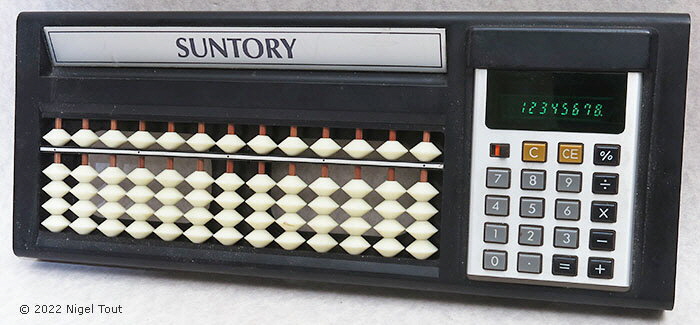Suntory combined soroban and electronic calculator

Suntory combined soroban and electronic calculator
Distinctive features: Combined soroban (Japanese-style abacus) and electronic calculator.
Technical details:
Soroban has 13 columns.
Calculator display is 8 digits, green vacuum-fluorescent (VFD).
Four functions, %.
1.5v (1 battery).
280 x 113 x 28 mm (11.0" x 4.4" x 1.1").
Since this is a basic calculator with a vacuum-fluorescent display (VFD) it is likely to date from about 1976-1978. Similar combinations are known where the electronic calculators have liquid crystal displays (LCDs), and so are likely to be slightly later.
The small electronic calculator is enclosed within the casing of the soroban with just a small aperture at the rear for replacing the single AA cell.
Suntory is a Japanese multinational brewing and distilling company group. This is probably a promotional item for the company.
In Japan many people were very proficient in using the soroban with great speed, though the basic electronic calculator could be advantageous for some multiplication and division calculations. Combining a soroban with an electronic calculator would have provided the advantages of each.
About the soroban Wikipedia says: "The soroban is composed of an odd number of columns or rods, each having beads: one separate bead having a value of five, called go-dama (五玉, ごだま, "five-bead") and four beads each having a value of one, called ichi-dama (一玉, いちだま, "one-bead"). Each set of beads of each rod is divided by a bar known as a reckoning bar.
The number of rods in a soroban is always odd and never fewer than seven. Basic models usually have thirteen rods, but the number of rods on practical or standard models often increases to 21, 23, 27 or even 31, thus allowing calculation of more digits or representations of several different numbers at the same time. Each rod represents a digit, and a larger number of rods allows the representation of more digits, either in singular form or during operations.
The beads and rods are made of a variety of different materials. Most soroban made in Japan are made of wood and have wood, metal, rattan, or bamboo rods for the beads to slide on. The beads themselves are usually biconal (shaped like a double-cone). They are normally made of wood, although the beads of some soroban, especially those made outside Japan, can be marble, stone, or even plastic. The cost of a soroban is commensurate with the materials used in its construction.
One unique feature that sets the soroban apart from its Chinese cousin is a dot marking every third rod in a soroban. These are unit rods and any one of them is designated to denote the last digit of the whole number part of the calculation answer. Any number that is represented on rods to the right of this designated rod is part of the decimal part of the answer, unless the number is part of a division or multiplication calculation. Unit rods to the left of the designated one also aid in place value by denoting the groups in the number (such as thousands, millions, etc.)."
Hand-held Calculators
Vintage Calculators
Text & photographs copyright, except where stated otherwise, © Nigel Tout 2000-2026.